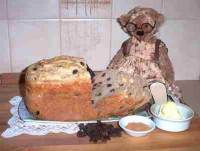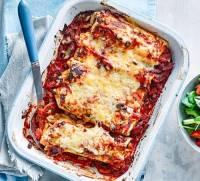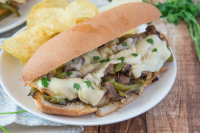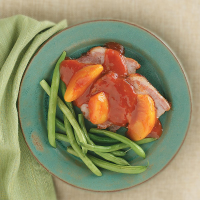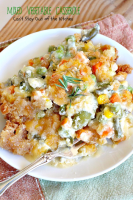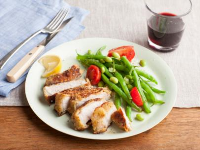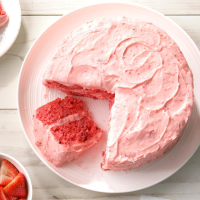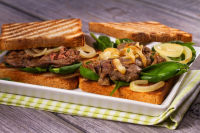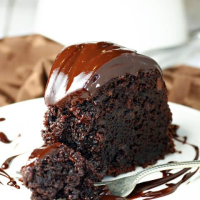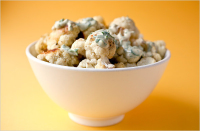HOW TO MAKE SOURDOUGH STARTER FROM SCRATCH | KITCHN
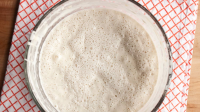
Making a fresh batch of starter is as easy as stirring together some flour and water and letting it sit.
Provided by Emma Christensen
Categories Sourdough bread Baked good Bread
Total Time 0S
Number Of Ingredients 2
Steps:
- Making sourdough starter takes about 5 days. Each day you "feed" the starter with equal amounts of fresh flour and water. As the wild yeast grows stronger, the starter will become more frothy and sour-smelling. On average, this process takes about 5 days, but it can take longer depending on the conditions in your kitchen. As long as you see bubbles and signs of yeast activity, continue feeding it regularly. If you see zero signs of bubbles after three days, take a look at the Troubleshooting section below.
- Day 1: Make the Initial Starter4 ounces all-purpose flour (3/4 cup plus 2 tablespoons) 4 ounces water (1/2 cup)
- Weigh the flour and water, and combine them in a 2-quart glass or plastic container (not metal). Stir vigorously until combined into a smooth batter. It will look like a sticky, thick dough. Scrape down the sides and loosely cover the container with plastic wrap or a clean kitchen towel secured with a rubber band.
- Place the container somewhere with a consistent room temperature of 70°F to 75°F (like the top of the refrigerator) and let sit for 24 hours.
- Day 2: Feed the Starter4 ounces all-purpose flour (3/4 cup + 2 tablespoons)4 ounces water (1/2 cup)
- Take a look at the starter. You may see a few small bubbles here and there. This is good! The bubbles mean that wild yeast have started making themselves at home in your starter. They will eat the sugars in the the flour and release carbon dioxide (the bubbles) and alcohol. They will also increase the acidity of the mixture, which helps fend off any bad bacterias. At this point, the starter should smell fresh, mildly sweet, and yeasty.
- If you don't see any bubbles yet, don't panic — depending on the conditions in your kitchen, the average room temperature, and other factors, your starter might just be slow to get going.
- Weigh the flour and water for today, and add them to the starter. Stir vigorously until combined into a smooth batter. It will look like a sticky, thick dough. Scrape down the sides and loosely cover the container with the plastic wrap or kitchen towel secured again. Place the container somewhere with a consistent room temperature of 70°F to 75°F (like the top of the refrigerator) and let sit for 24 hours.
- Day 3: Feed the Starter4 ounces all-purpose flour (3/4 cup + 2 tablespoons)4 ounces water (1/2 cup)
- Check your starter. By now, the surface of your starter should look dotted with bubbles and your starter should look visibly larger in volume. If you stir the starter, it will still feel thick and batter-like, but you'll hear bubbles popping. It should also start smelling a little sour and musty. Again, if your starter doesn't look quite like mine in the photo, don't worry. Give it a few more days. My starter happened to be particularly vigorous!
- Weigh the flour and water for today, and add them to the starter. Stir vigorously until combined into a smooth batter. It will look like a sticky, thick dough. Scrape down the sides and loosely cover the container with the plastic wrap or kitchen towel secured again. Place the container somewhere with a consistent room temperature of 70°F to 75°F (like the top of the refrigerator) and let sit for 24 hours.
- Day 4: Feed the Starter4 ounces all-purpose flour (3/4 cup + 2 tablespoons)4 ounces water (1/2 cup)
- Check your starter. By now, the starter should be looking very bubbly with large and small bubbles, and it will have doubled in volume. If you stir the starter, it will feel looser than yesterday and honeycombed with bubbles. It should also be smelling quite sour and pungent. You can taste a little too! It should taste sour and somewhat vinegary.
- When I made my starter here, I didn't notice much visual change from Day 3 to Day 4, but could tell things had progress by the looseness of the starter and the sourness of the aroma.
- Weigh the flour and water for today, and add them to the starter. Stir vigorously until combined into a smooth batter. It will look like a sticky, thick dough. Scrape down the sides and loosely cover the container with the plastic wrap or kitchen towel secured again. Place the container somewhere with a consistent room temperature of 70°F to 75°F (like the top of the refrigerator) and let sit for 24 hours.
- Day 5: Starter is Ready to UseCheck your starter. It should have doubled in bulk since yesterday. By now, the starter should also be looking very bubbly — even frothy. If you stir the starter, it will feel looser than yesterday and be completely webbed with bubbles. It should also be smelling quite sour and pungent. You can taste a little too! It should taste even more sour and vinegary.
- If everything is looking, smelling, and tasting good, you can consider your starter ripe and ready to use! If your starter is lagging behind a bit, continue on with the Day 5 and Beyond instructions.
- Day 5 and Beyond: Maintaining Your Starter4 ounces all-purpose flour (3/4 cup + 2 tablespoons)4 ounces water (1/2 cup)
- Once your starter is ripe (or even if it's not quite ripe yet), you no longer need to bulk it up. To maintain the starter, discard (or use) about half of the starter and then "feed" it with new flour and water: weigh the flour and water, and combine them in the container with the starter. Stir vigorously until combined into a smooth batter.
- If you're using the starter within the next few days, leave it out on the counter and continue discarding half and "feeding" it daily. If it will be longer before you use your starter, cover it tightly and place it in the fridge. Remember to take it out and feed it at least once a week — I also usually let the starter sit out overnight to give the yeast time to recuperate before putting it back in the fridge.
- How to Reduce the Amount of StarterMaybe you don't need all the starter we've made here on an ongoing basis. That's fine! Discard half the starter as usual, but feed it with half the amount of flour and water. Continue until you have whatever amount of starter works for your baking habits.
- How to Take a Long Break from Your StarterIf you're taking a break from baking, but want to keep your starter, you can do two things:1) Make a Thick Starter: Feed your starter double the amount of flour to make a thicker dough-like starter. This thicker batter will maintain the yeast better over long periods of inactivity in the fridge.2) Dry the Starter: Smear your starter on a Silpat and let it dry. Once completely dry, break it into flakes and store it in an airtight container. Dried sourdough can be stored for months. To re-start it, dissolve 1/4 cup of the flakes in 4 ounces of water, and stir in 4 ounces of flour. Continue feeding the starter until it is active again.
Nutrition Facts : SaturatedFatContent 0 g, UnsaturatedFatContent 0.0 g, CarbohydrateContent 0 g, SugarContent 0 g, ServingSize Serves 0, ProteinContent 0 g, FatContent 0 g, Calories 0 cal, SodiumContent 0 mg, FiberContent 0 g, CholesterolContent 0 mg
SOURDOUGH STARTER RECIPE: HOW TO MAKE IT
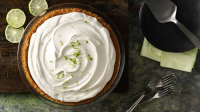
Many years ago, I received this recipe and some starter from a good friend. I use it to make my own sourdough bread. —Delila George, Junction City, Oregon
Provided by Taste of Home
Total Time 10 minutes
Prep Time 10 minutes
Cook Time 0 minutes
Yield about 3 cups.
Number Of Ingredients 3
Steps:
- In a covered 4-qt. glass or ceramic container, mix flour and yeast. Gradually stir in warm water until smooth. Cover loosely with a kitchen towel; let stand in a warm place 2-4 days or until mixture is bubbly and sour smelling and a clear liquid has formed on top. (Starter may darken, but if starter turns another color or develops an offensive odor or mold, discard it and start over.) , Cover tightly and refrigerate starter until ready to use. Use and replenish starter, or nourish it, once every 1-2 weeks.
To use and replenish starter:
Stir to blend in any liquid on top. Remove amount of starter needed; bring to room temperature before using. For each 1/2 cup starter removed, add 1/2 cup flour and 1/2 cup warm water to the remaining starter and stir until smooth. Cover loosely and let stand in a warm place 1-2 days or until light and bubbly. Stir; cover tightly and refrigerate.
To nourish starter:
Remove half of the starter. Stir in equal parts of flour and warm water; cover loosely and let stand in a warm place 1-2 days or until light and bubbly. Stir; cover tightly and refrigerate.
Nutrition Facts : Calories 19 calories, FatContent 0 fat (0 saturated fat), CholesterolContent 0 cholesterol, SodiumContent 0 sodium, CarbohydrateContent 4g carbohydrate (0 sugars, FiberContent 0 fiber), ProteinContent 1g protein.
More about "how to make sour dough starter recipes"
HOW TO MAKE SOURDOUGH BREAD - BBC FOOD
To make this bread you need to use a ‘starter’ mixture that takes the place of yeast. The starter takes about 5 days to develop (or you can buy it online), but once you have it you can keep it alive and use it whenever needed.
From bbc.co.uk
Reviews 4.4
From bbc.co.uk
Reviews 4.4
- Preheat the oven to 230C/210C Fan/Gas 8. Put a few ice cubes or cold water into a baking tin and place in the bottom of the oven to create steam. Turn the loaves out onto a baking tray or hot baking stone. Using a thin sharp knife score two or three times on the top of the loaf and place in the oven. Bake for 35–40 minutes or until a good crust has formed and the loaves sound hollow when tapped on the base.
See details
HOW TO MAKE SOURDOUGH STARTER FROM SCRATCH | KITCHN
Making a fresh batch of starter is as easy as stirring together some flour and water and letting it sit.
From thekitchn.com
Reviews 3.4
Total Time 0S
Category Sourdough bread, Baked good, Bread
Calories 0 cal per serving
From thekitchn.com
Reviews 3.4
Total Time 0S
Category Sourdough bread, Baked good, Bread
Calories 0 cal per serving
- How to Take a Long Break from Your StarterIf you're taking a break from baking, but want to keep your starter, you can do two things:1) Make a Thick Starter: Feed your starter double the amount of flour to make a thicker dough-like starter. This thicker batter will maintain the yeast better over long periods of inactivity in the fridge.2) Dry the Starter: Smear your starter on a Silpat and let it dry. Once completely dry, break it into flakes and store it in an airtight container. Dried sourdough can be stored for months. To re-start it, dissolve 1/4 cup of the flakes in 4 ounces of water, and stir in 4 ounces of flour. Continue feeding the starter until it is active again.
See details
SOURDOUGH STARTER RECIPE: HOW TO MAKE IT
Many years ago, I received this recipe and some starter from a good friend. I use it to make my own sourdough bread. —Delila George, Junction City, Oregon
From tasteofhome.com
Reviews 4.9
Total Time 10 minutes
Calories 19 calories per serving
From tasteofhome.com
Reviews 4.9
Total Time 10 minutes
Calories 19 calories per serving
- In a covered 4-qt. glass or ceramic container, mix flour and yeast. Gradually stir in warm water until smooth. Cover loosely with a kitchen towel; let stand in a warm place 2-4 days or until mixture is bubbly and sour smelling and a clear liquid has formed on top. (Starter may darken, but if starter turns another color or develops an offensive odor or mold, discard it and start over.) , Cover tightly and refrigerate starter until ready to use. Use and replenish starter, or nourish it, once every 1-2 weeks.
To use and replenish starter:
Stir to blend in any liquid on top. Remove amount of starter needed; bring to room temperature before using. For each 1/2 cup starter removed, add 1/2 cup flour and 1/2 cup warm water to the remaining starter and stir until smooth. Cover loosely and let stand in a warm place 1-2 days or until light and bubbly. Stir; cover tightly and refrigerate.
To nourish starter:
Remove half of the starter. Stir in equal parts of flour and warm water; cover loosely and let stand in a warm place 1-2 days or until light and bubbly. Stir; cover tightly and refrigerate.
See details
HOW TO MAKE SOURDOUGH BREAD - BBC FOOD
To make this bread you need to use a ‘starter’ mixture that takes the place of yeast. The starter takes about 5 days to develop (or you can buy it online), but once you have it you can keep it alive and use it whenever needed.
From bbc.co.uk
Reviews 4.4
From bbc.co.uk
Reviews 4.4
- Preheat the oven to 230C/210C Fan/Gas 8. Put a few ice cubes or cold water into a baking tin and place in the bottom of the oven to create steam. Turn the loaves out onto a baking tray or hot baking stone. Using a thin sharp knife score two or three times on the top of the loaf and place in the oven. Bake for 35–40 minutes or until a good crust has formed and the loaves sound hollow when tapped on the base.
See details
SOURDOUGH STARTER | HOW TO MAKE A SOUR DOUGH STARTER KI…
The level of sourness in a sourdough starter can be manipulated to some degree. While a few starters are known for their particular tang, others can be sour or mild, depending on the starter’s hydration level, the flour used, and the proofing time. LEARN MORE: Manipulating the Sourness of Your Sourdough. 3. Sour Dough Starter …
From culturesforhealth.com
From culturesforhealth.com
See details
SOURDOUGH STARTER, SOUR DOUGH STARTER TOOLS FOR COOKS AND ...
The San Francisco sour dough starter also makes wonderful pancakes and waffles too. Take a look at the sourdough recipes on the Recipes page. By the way, shipping for the Sourdough Starter to …
From sourdoughbreads.com
From sourdoughbreads.com
See details
HOW TO MAKE SOURDOUGH BREAD MORE SOUR TASTING ~ HOMESTEA…
Jan 29, 2021 · Another way to make sourdough more sour is to let refrigerated dough sit out at room temperature for 30 to 60 minutes before baking, but that too can negatively affect “oven spring”. (You get the best oven spring by quickly transferring cold dough …
From homesteadandchill.com
From homesteadandchill.com
See details
PIZZA DOUGH WITH SOURDOUGH STARTER RECIPE - NYT COOKING
In the bowl of a stand mixer, combine the flours and salt, then add the starter and water. Mix with a wooden spoon until the dough begins to bind, then let rest for 5 minutes. Using the dough hook, knead on the mixer’s second-lowest setting for 5 to 7 minutes, until dough …
From cooking.nytimes.com
From cooking.nytimes.com
See details
HOW TO MAKE SOURDOUGH MORE SOUR | TIPS ON MANIPULATING ...
2. Adjust the Bread Dough. Use more sourdough starter in the dough. A larger percentage of sourdough starter in the dough allows it to both rise in a cooler location and have a shorter rising time. Both of these conditions help to tame the sourness in sourdough by lowering acetic acid production. (The amount of starter …
From culturesforhealth.com
From culturesforhealth.com
See details
18 WAYS TO MAKE SOURDOUGH BREAD MORE (OR LESS) SOUR ...
12. Using Smaller Amounts of Starter in the Recipe will make your Bread More Sour. Another way of manipulating the sourness of your dough is to play around with the amount of starter you use. The smaller the amount of starter in the recipe, the more sour …
From truesourdough.com
From truesourdough.com
See details
SOURDOUGH - WIKIPEDIA
The leaven is mixed with flour and water to make a final dough of the desired consistency. The starter weight is usually 13% to 25% of the total flour weight, though formulas may vary. The dough is shaped into loaves, left to rise, and then baked. A number of 'no knead' methods are available for sourdough …
From en.m.wikipedia.org
From en.m.wikipedia.org
See details
HOW TO MAKE YOUR OWN SOURDOUGH STARTER | BAKEPROOF …
Jun 20, 2017 · Wild yeast works more slowly than commercial yeast so recipes made with a sourdough starter will typically take longer to make. Making a sourdough starter is a simple process …
From sbs.com.au
From sbs.com.au
See details
HOW TO MAKE YOUR OWN SOURDOUGH STARTER - THE PRAIRI…
Dec 22, 2021 · It doesn’t make a sour flavored sourdough loaf unless you leave the bread dough processing for a long enough period of time to develop the sour flavor (usually over 12-24 hours). If you have a happy bubbly starter …
From theprairiehomestead.com
From theprairiehomestead.com
See details
SAN FRANCISCO SOURDOUGH BREAD RECIPE | ALLRECIPES
Maybe it is a matter of how wet your sour dough starter is, but my dough is about right when I've added three cups of bread flour, rather than the 4-3/4 called for in the recipe. I also add two tablespoons of vital wheat gluten, to make the dough …
From allrecipes.com
From allrecipes.com
See details
SOURDOUGH BAGUETTES - KING ARTHUR BAKING
Stir until the dough pulls away from the sides of the bowl, adding only enough additional flour as necessary; a slack (sticky) dough makes a light loaf. Knead the dough for about 7 minutes in a …
From kingarthurbaking.com
From kingarthurbaking.com
See details
HOW TO MAKE SOURDOUGH BREAD | SOURDOUGH BREAD RECIPE & H…
Mix sourdough starter, flour, and salt together. Add 1 cup water, then more as needed to make a moist bread dough. Knead dough until it passes the “window pane test.” That is, a small piece of dough will stretch between four fingers thin enough to allow light to pass through without breaking. Split the dough …
From culturesforhealth.com
From culturesforhealth.com
See details
SOURDOUGH STARTER, SOUR DOUGH STARTER TOOLS FOR COOKS AND ...
The San Francisco sour dough starter also makes wonderful pancakes and waffles too. Take a look at the sourdough recipes on the Recipes page. By the way, shipping for the Sourdough Starter to …
From sourdoughbreads.com
From sourdoughbreads.com
See details
HOW TO MAKE SOURDOUGH BREAD MORE SOUR TASTING ~ HOMESTEA…
Jan 29, 2021 · Another way to make sourdough more sour is to let refrigerated dough sit out at room temperature for 30 to 60 minutes before baking, but that too can negatively affect “oven spring”. (You get the best oven spring by quickly transferring cold dough …
From homesteadandchill.com
From homesteadandchill.com
See details
18 WAYS TO MAKE SOURDOUGH BREAD MORE (OR LESS) SOUR ...
12. Using Smaller Amounts of Starter in the Recipe will make your Bread More Sour. Another way of manipulating the sourness of your dough is to play around with the amount of starter you use. The smaller the amount of starter in the recipe, the more sour …
From truesourdough.com
From truesourdough.com
See details
SAN FRANCISCO SOURDOUGH BREAD RECIPE | ALLRECIPES
Maybe it is a matter of how wet your sour dough starter is, but my dough is about right when I've added three cups of bread flour, rather than the 4-3/4 called for in the recipe. I also add two tablespoons of vital wheat gluten, to make the dough …
From allrecipes.com
From allrecipes.com
See details
SOURDOUGH BAGUETTES - KING ARTHUR BAKING
Stir until the dough pulls away from the sides of the bowl, adding only enough additional flour as necessary; a slack (sticky) dough makes a light loaf. Knead the dough for about 7 minutes in a …
From kingarthurbaking.com
From kingarthurbaking.com
See details
HOW TO MAKE SOURDOUGH BREAD | SOURDOUGH BREAD RECIPE & H…
Mix sourdough starter, flour, and salt together. Add 1 cup water, then more as needed to make a moist bread dough. Knead dough until it passes the “window pane test.” That is, a small piece of dough will stretch between four fingers thin enough to allow light to pass through without breaking. Split the dough …
From culturesforhealth.com
From culturesforhealth.com
See details















